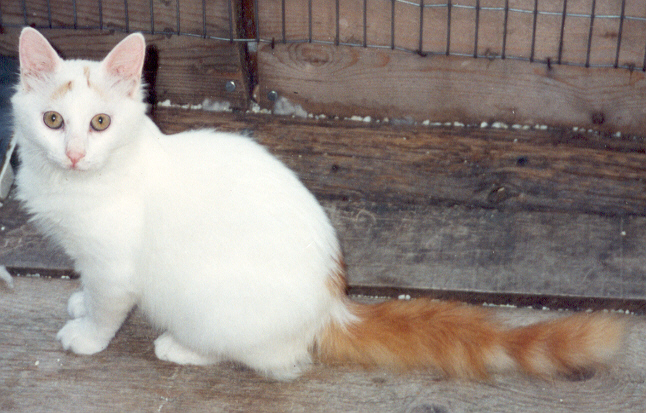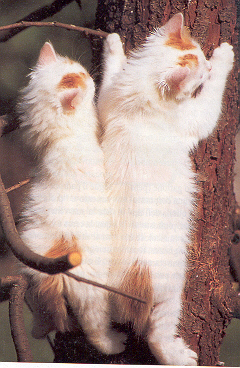TURK VAN

GENERAL: The Turkish Van is a natural breed from the rugged, remote and climatically varied region of the Middle East. The breed is known for its unique, distinctive pattern...the term "van" has been adopted by a variety of breeds to describe white cats with colored head and tail markings. The Turkish Van is a solidly-built, semi-longhaired cat with great breadth to the chest. The strength and power of the cat is evidenced in its substantial body and legs. This breed takes a full 3 to 5 years to reach full maturity and development, therefore allowances must be made for age and sex. Turkish Vans are very intelligent and alert cats, and as such feel more secure, and handle better with all four feet on a solid surface. SUGGESTED BREEDINGS by MENANDPETS.COM
No breeding to signal
if you want to know like signaling yours, contacts: marketing@inseparabile.it
BALANCE: Despite age and sex, as adults, individuals should convey an overall impression of a well-balanced and well-proportioned appearance in which no feature is exaggerated to foster weakness or extremes.
HEAD: Substantially broad wedge, with gentle contours and a medium length nose to harmonize with the large muscular body, ears are not to be included in the wedge. Prominent cheekbones. In profile, the nose has a slight dip below eye level marked by a change in the direction the hair lays. Allowances must be made for jowling in the males. Firm chin in a straight line with the nose and upper lip; rounded muzzle.
EARS: Moderately large, in proportion to the body, set fairly high and well apart; the inside edge of the ear is slightly angled to the outside with the outside edge fairly straight but not necessarily in line with the side of the face; wide at the base. Tips are slightly rounded. Insides should be well feathered.
EYES: Moderately large, a rounded aperture slightly drawn out at the corners, set at a slant, equidistant from the outside base of the ear to the tip of the nose. Eyes should be clear, alert and expressive.
BODY: moderately long, sturdy, broad, muscular and deep-chested. Mature males should exhibit marked muscular development in the neck and shoulders. The shoulders should be at least as broad as the head, and flow into the well-rounded ribcage and then into a muscular hip and pelvic area. Turkish Van males are substantially larger than females and exhibit much greater development.
LEGS AND FEET: Moderately long, muscular legs. They are set wide apart and taper to rounded moderately large feet. Legs and feet should be in proportion to the body. Toes, five in front, four GO BACK TO LIST.
TAIL: Long, but in proportion to the body, with a brush appearance. Tail hair length is keeping with the semi-long coat length.
COAT: Semi-long with a cashmere-like texture; soft to the roots with no trace of undercoat. Due to the extremes in climate of their native region, the breed carries two distinctive coat lengths and allowances must be made for the seasonal coat. The summer coat is short, conveying the appearance of a shorthair; the winter coat is substantially longer and thicker. There is feathering on the ears, legs, feet and belly. Facial fur is short. A frontal neck ruff and full brush tail become more pronounced with age. The above description is that of an adult, allowances must be made for short coats and tail hair on kittens and young adults.
COLOR and PATTERN: Van pattern only on glistening chalk-white body with colored markings confined to the head and tail is preferred. One or more random markings, up to color on 15% of the entire body (excluding the head and tail color), are permissible. Random markings should not be of a size or number to detract from the van pattern, making a specimen appear bi-color. A symmetrical pattern of head markings, divided by white up to at least the level of the front edge of the ears, is desirable.
PENALIZE: any evidence toward extremes (i.e. short cobbiness or svelte, fine-boning); greater than 20% white in the tail, flat profile.
DISQUALIFY: total absence of color in the area from eye level up to the back of the head or tail; definite nose break; genetic/skeletal defects such as flattened ribcage, kinked or abnormal tail, incorrect number of toes, crossed eyes. Color in excess of 20% of the entire body.
TURKISH VAN COLORS
Eye color on all coat colors: amber, blue and odd-eyed. Eye color may fade with age.
Nose leather on all coat colors: pink.
Paw pads on all coat colors: pink is preferable but color spot(s) on paw pads acceptable due to the two colors in the pattern.
Solid and White Colors
RED: ranging from warm red to deep auburn, but should be one level shade, sound to the roots.
CREAM: one level shade of buff cream, sound to the roots.
BLACK: dense coal black, sound to the roots. Free of any tinge of rust on tips or smoke undercoat.
BLUE: one level tone of blue, sound to the roots.
Tabby and White Colors
Tabby markings are dense and clearly defined. How much of the tabby marking is seen is highly dependent on the size and placement of the head and body spots. A spot may be of a size that only ground color or only the tabby stripe is seen, thus there may not be enough color to determine whether the markings are classic or mackerel.
RED TABBY: ground color creamy red. Tabby markings range from warm red to deep auburn.
CREAM TABBY: ground color very pale cream. Tabby markings of buff cream sufficiently darker than the ground color to afford good contrast but remaining within the dilute range.
BROWN TABBY: ground color creamy beige. Tabby markings dense black.
BLUE TABBY: ground color pale bluish ivory. Tabby markings a deep blue affording a good contrast with ground color. Warm fawn or patina over the colored portions.
Parti-color and White Colors
TORTOISESHELL: black and red patches with tabby markings allowed in the red portion.
DILUTE TORTOISESHELL: blue and cream patches with tabby markings allowed in the cream portion.
BROWN PATCHED TABBY (Torbie): brown tabby description with patches of red or red tabby.
BLUE PATHED TABBY )Dilute Torbie): blue tabby description with patches of cream or cream tabby.
*Note: It is characteristic of the Turkish Van breed to carry tabby markings in the red/cream portions of the tortoiseshell colors.
OTVC (Other Turkish Van Colors): van pattern only - any other color and white (silver tabby, smokes, etc.) with the exception of those showing evidence of hybridization resulting from the Himalayan pattern (point restricted) and colors (chocolate, lilac, etc.).
above the CFA Breed Standards
after automatic translate from inseparabile.com
For centuries dived in the great lago of Van that
extends on the Armenian plateau to 1700 meters on the sea and the
slopes of the Ararat mount, trying food in its icy waters.
It is
born therefore in a climate that goes the most rigid winter
temperatures to the summery torrid warmth.
Because of the
environmental conditions them, its corporatura developed strongly,
powerful and muscolosa, but extremely agile.
E' the only cat
swimmer of the great family of the feline small and known also with
the name of "cat of Allah".
They love therefore the water and
they are most skillful fishermen, but in the warm summery days they
are not only dived for procacciarsi the food, bens for the pleasure
to enjoy one beautiful and long swim.
Perci attention to who
wanted some to possess one, not us sar bowl, puddle, small basin,
bathtub or swimming pool to which sapr resisting.
In all Turkey,
but also in Armenia much popular and considered race protect, a lot
that ministerial permissions for the export are necessary.
We
find testimonies of this race in some reperti archaeological of the
period of the roman occupation in Armenia (75 - 387 d.C.), it is be
a matter of shield on which are represents cats to you white men to
semilong hair with spots on the head and folta anellata tail,
exactly the same characteristics that distinguish also the Van Turks
today.
Its discovery must to two English tourists, Laura
Lushington and Sonia Halliday who in the 1955 remained fascinated
these liveliest cats that swam in the lago of Van.
Of it they
imported two subjects, a male and a female and with these they began
a breeding program action to maintain the characteristics originates
them.
The GCCF recognized the race in 1969 and in 1971 it only
came recognized also from the FiFe.
All over the world, little
are the breedings of Van Turk, and just for the insufficient one
possibilit that it is had to export them from Turkey, ago s that
they are truly rare cats.

Colors
It has a fur that having itself to adapt to the
strongest thermal excursion anniversary, in long winter, folta and
setosa, while in summer it endures a true and own metamorphosis
becoming short, excluded the flowing tail that it remains folta and.
E' exclusively of color white man chalk with two spots on the
forehead and the tail of red color or cream.
These spots come
calls "prints of Allah".
A legend in fact narrates that Allah,
taking a walk, saw a cat completely white man, in appearing
difficolt within the lago of Van, and wanting it "to save" it drew
it aloft taking it for the head and the tail.
But very soon the
lago riemp of other cats white men who calmly swam.
Fascinated
and amused, Allah lasci on the soft cape white man chalk the
indelebili red prints just l where it had touched the first one.
Naturally the cape of the Van Turk lacking in sottopelo and is
dried up easy after to be exited from the water.
Breeding
Accustomed to
impossible temperatures, healthy a sturdy cat and of and lively
appetite, for which it does not have need of many cures.
The
mothers are incredibly gelose and attend to the puppys in mirabile
way.
The cape, to semilong hair and without sottopelo, avr need
only of little brushed every a lot.
We have for to that to make
with a impegnativo temperament and one personalit much fort.
Most affectionate, lively, ardent, possessivo and geloso, it
loves the company of the persons and dislikes to only remain for
many hours.
Much touchy E' and is taken offense very many when
it comes sgridato or punished, but even if has decided not to pardon
never devout who has dared to insult it a lot villanamente, does not
know to resist to the temptation of the game, enough one little
ball, topolino of pezza or also a simple one pezzetto of paper, for
fargli forgetting the endured twisted one.
It loves the man, but
not equally the other animals of which gelosissimo in its
relationships with the master.
If it something comes tax, pu to
rather become aggressive, that potr to constitute a problem from the
veterinary or to the exposures, where in effects to of l of its
rarit, often absent because of its caratterino.
E' difficult to
only obtain a beautiful spotted cape from the "prints of Allah".
Two or three macchiette are granted to others in all the body
(better if not there are) otherwise risulter a cat from not suitable
company and for the reproduction.
To obtain this type of
perfection of the most difficult cape, like equally difficult sar
trovargli a master ideal, than dovr to be one person estroversa and
loving of these irreducible ones chiacchieroni.
INSEPARABLE THE MRS. RINGRAZIA FOR THE REALIZATION OF THIS
CARD
. emanuela d'amaro
. STREGATTO
. breeders breeds RARE - GATTO EUROPEO E TURCO
VAN
.
http://www.stregattocats.it/
.
stregattoturco@interfree.it
. Via Vicenza Nr 4
.
35028 Piove di Sacco (PD)
tel. . 049/5856003
.
Cell.328/4050861